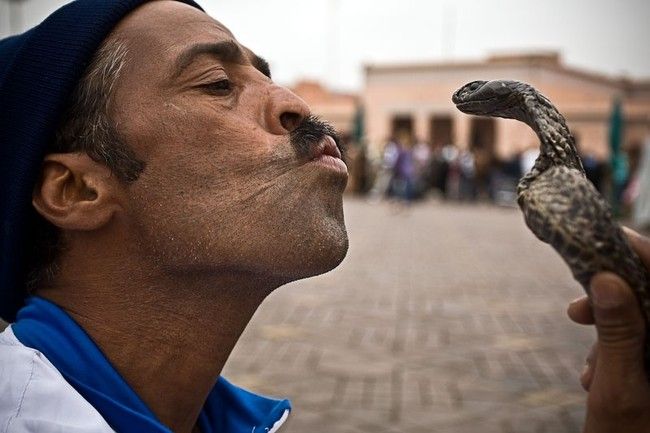|
|
Snake Magician, Morocco, Marrakech
|
Bite
Snakes do not ordinarily prey on humans, and most will not attack humans unless the snake is startled or injured, preferring instead to avoid contact. With the exception of large constrictors, nonvenomous snakes are not a threat to humans. The bite of nonvenomous snakes is usually harmless because their teeth are designed for grabbing and holding, rather than tearing or inflicting a deep puncture wound. Although the possibility of an infection and tissue damage is present in the bite of a nonvenomous snake, venomous snakes present far greater hazard to humans.:209
Documented deaths resulting from snake bites are uncommon. Nonfatal bites from venomous snakes may result in the need for amputation of a limb or part thereof. Of the roughly 725 species of venomous snakes worldwide, only 250 are able to kill a human with one bite. Australia averages only one fatal snake bite per year. In India, 250,000 snakebites are recorded in a single year, with as many as 50,000 recorded initial deaths.
The treatment for a snakebite is as variable as the bite itself. The most common and effective method is through antivenom (or antivenin), a serum made from the venom of the snake. Some antivenom is species specific (monovalent) while some is made for use with multiple species in mind (polyvalent). In the United States for example, all species of venomous snakes are pit vipers, with the exception of the coral snake. To produce antivenom, a mixture of the venoms of the different species of rattlesnakes, copperheads, and cottonmouths is injected into the body of a horse in ever-increasing dosages until the horse is immunized. Blood is then extracted from the immunized horse; the serum is separated and further purified and freeze-dried. It is reconstituted with sterile water and becomes antivenom. For this reason, people who are allergic to horses are more likely to suffer an allergic reaction to antivenom. Antivenom for the more dangerous species (such as mambas, taipans, and cobras) is made in a similar manner in India, South Africa, and Australia, although these antivenoms are species-specific.
|
|









